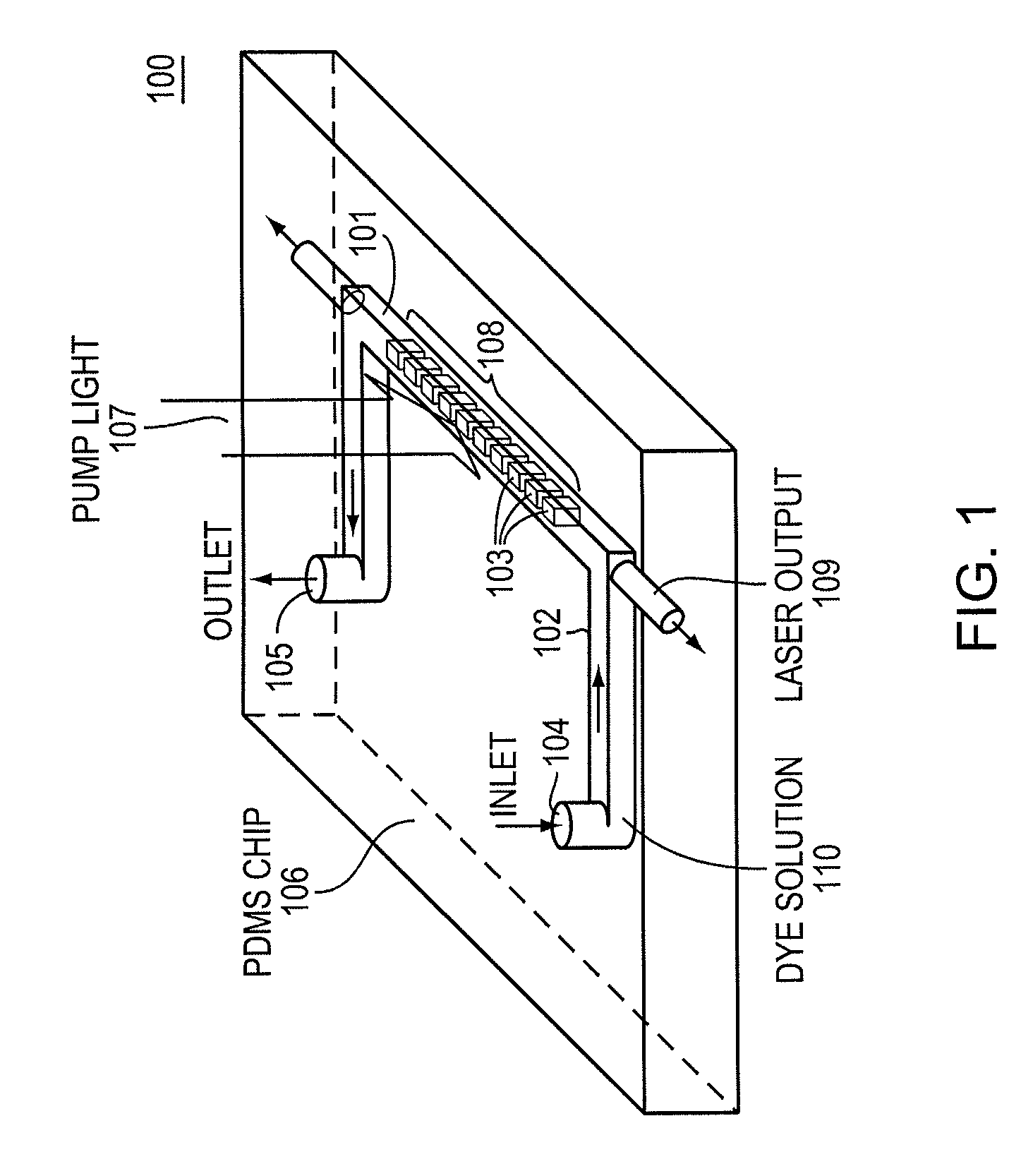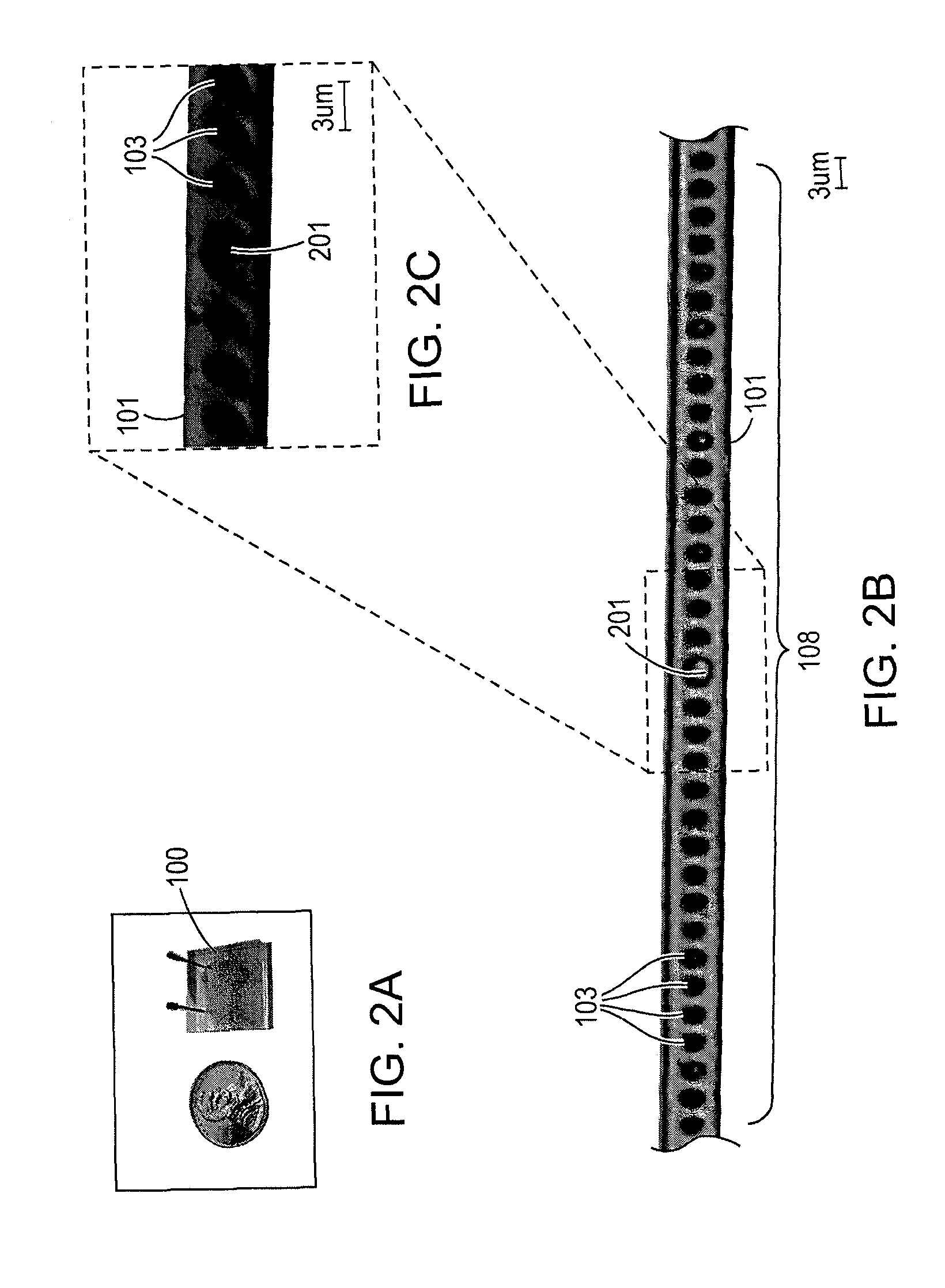Mechanically tunable elastomeric optofluidic distributed feedback dye lasers
a distributed feedback and optofluidic technology, applied in lasers, laser details, active medium materials, etc., can solve the problems of unfavorable dye selection and dye concentration, microfluidic laser wavelength tuning, and undetectable simultaneous multiple modes of operation and wide emission line widths
- Summary
- Abstract
- Description
- Claims
- Application Information
AI Technical Summary
Benefits of technology
Problems solved by technology
Method used
Image
Examples
example 1
[0059]Briefly, a master mold was fabricated using conventional photolithography. 2 um thick SU8-2002 negative photoresist (available from the MicroChem. Corp. of Newton, Mass.) was spin-coated on a silicon wafer and patterned with a Cr-on-glass mask. The mold was treated with trimethylchlorosilane (available from the Sigma-Aldrich Co. of St. Louis, Mo.) for 3 min before use to facilitate the release of PDMS. Then 5:1 part A:B PDMS prepolymer (GE RTV 615, General Electric (“GE”) Sealants RTV Products-Elastomers) was poured onto the mold and baked at 80° C. for 30 min. The partially cured PDMS was peeled from the master and the liquid inlet and outlet ports were punched through the whole layer using a 23-gauge luer-stub adapter. The patterned PDMS, containing the laser structure, was then treated with oxygen plasma and bonded to another featureless PDMS to form a monolithic device. Finally, the resulting device was cut to size and baked overnight at 80° C. FIG. 2A shows an illustratio...
example 2
[0061]A microfluidic dye laser of the type shown in FIG. 1 was fabricated and tested. The optical waveguide dimensions (width 5 μm; height 2 μm) were chosen such that when filled with liquid of refractive index 1.409, the waveguide supported only the two fundamental E11 modes. If we define the x direction along the width and the y direction along the height, the E11x mode (transverse E field along x direction, considered to be TE-like) is more confined than the E11y mode, and thus is the preferred lasing mode. The small cross-section area not only reduces the required pump power to achieve the lasing threshold but also resulted in an extremely small consumption of dye solution (less than 40 picoliter per channel per fill).
[0062]To obtain stable single frequency operation, the free spectral range (“FSR”) of the employed cavity structure has to be larger than the gain spectral bandwidth. Organic dye molecules are well known to have very broad gain spectra with a typical bandwidth of 3...
example 3
[0068]A dye solution was introduced into the microfluidic channel of the microfluidic laser of example 2, by applying 10 psi pressure at an inlet port. It was found that to operate the laser in the pulsed mode that it was not necessary to circulate the dye solution, although continuous circulation of the dye solution did increase the output power. The laser chip was optically pumped with 6 ns Q-switched Nd:YAG laser pulses of 532 nm wavelength, focused to a ˜100 μm wide stripe aligned with the microfluidic channel. A 10× microscope objective was used to collect the emission light from one edge of the chip and deliver the emission light to a fiber coupled CCD-array based spectrometer, Ocean Optics model no. HR4000 having a 0.1 nm resolution (manufactured by Ocean Optics, Inc. of Dunedin, Fla.). A typical single mode lasing spectrum is shown in FIG. 4 where the lasing wavelength is 567.3 nm, very close to the predicted value 563 nm. The measured linewidth (inset “A”) is 0.21 nm. A plo...
PUM
 Login to View More
Login to View More Abstract
Description
Claims
Application Information
 Login to View More
Login to View More - R&D
- Intellectual Property
- Life Sciences
- Materials
- Tech Scout
- Unparalleled Data Quality
- Higher Quality Content
- 60% Fewer Hallucinations
Browse by: Latest US Patents, China's latest patents, Technical Efficacy Thesaurus, Application Domain, Technology Topic, Popular Technical Reports.
© 2025 PatSnap. All rights reserved.Legal|Privacy policy|Modern Slavery Act Transparency Statement|Sitemap|About US| Contact US: help@patsnap.com



